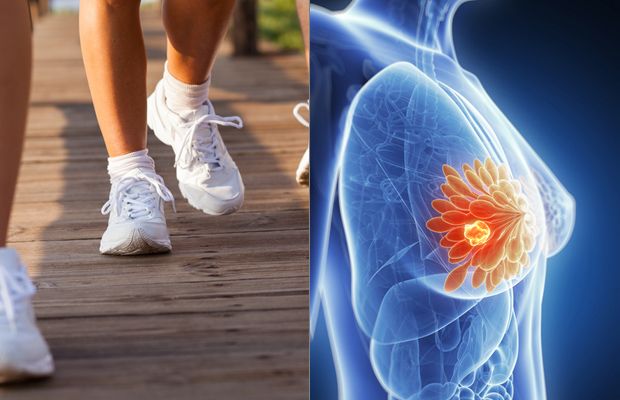Fitness
Plant-Based Diet/Exercise Tied to Weight Loss in HR+ Breast Cancer

Patients with hormone receptor-positive breast cancer experienced weight loss when given a plant-based diet plus exercise.
A positive correlation between personalized plant-based diets (PBD) plus exercise therapy and reduced body weight plus increased fat loss was noted in women who are postmenopausal with hormone receptor (HR)–positive breast cancer who are receiving aromatase inhibitor therapy, according to results from a phase 2 trial (NCT04298086).1
Results from the trial were presented in a poster during the 2024 American Society of Clinical Oncology (ASCO) Annual Meeting. The mean weight loss in the PBD plus exercise therapy group was –13% (standard deviation [SD], 6%), vs –5% (SD, 6%) in the control group. The mean between group difference was –8kg. Additionally, no adverse effects were observed in the trial (95% CI, –11 to –4).
“Personalized PBD plus exercise therapy led to substantial weight loss and favorable changes in body composition during endocrine therapy for [patients with] HR–positive breast cancer,” Neil M. Iyengar, MD, associate attending physician at Memorial Sloan Kettering Cancer Center, and co-editor-in chief of ONCOLOGY®, and study authors wrote in the poster.
Overall, 43 women who were postmenopausal with HR–positive primary breast cancer were randomly assigned to the trial between August 2020 and April 2023. The mean body mass index (BMI) was 34 kg/m2. The aim of the trial was to observe the effects of PBD and exercise therapy on weight and body composition in this population.
Data showed of the 43 women, 21 were enrolled in the control group and 22 were enrolled in the PBD plus exercise group. The mean age at consent for each group was 58 (SD, 7) and 56 (SD, 7), respectively. The mean BMI was 34.2 (SD, 4) and 34.3 (SD, 5). In the control group, 52% had stage I disease, 33% had stage II, and 14% had stage III. In the PBD plus exercise group, 55% had stage I disease, 36% had stage II, and 9% had stage III.
Findings also show that mean fat loss in the PBD plus exercise therapy group was –6 kg and the control group was –2 kg. Furthermore, lean mass increases were greater in the PBD plus exercise therapy group vs the control group (P <.001 additionally="" the="" weekly="" energy="" deficit="" goal="" compliance="" was="" in="" month="" and="" wp_automatic_readability="30">
Data showed a change in weight (kg) of –4 (95% CI, –6.6 to –2.2) in the control and –12 (95% CI, –15 to –9.4) in the PBD plus exercise group (P <.001 changes="" in="" total="" body="" fat="" were="" ci="" to="" the="" control="" group="" and="" pbd="" plus="" exercise="" wp_automatic_readability="24">P <.001 additionally="" the="" change="" in="" total="" body="" lean="" mass="" was="" ci="" control="" group="" and="" pbd="" plus="" exercise="" group.="" wp_automatic_readability="48">
The PBD plus exercise group received individualized weekly-adjusted caloric goals, with a targeted 500 kcal/day goal deficit. This was achieved through nutrition coaching and meal delivery. Changes in weight and body composition post-intervention, measured by dual-energy x-ray absorptiometry (DXA), were assessed between arms using linear mixed models.
In the PBD plus exercise therapy arm, exercise treatment consisted of individualized walking less than or equal to 7 times weekly, with training sessions performed on a remotely surveilled treadmill.2 Plant-based diets consisted of home-delivered pre-prepared meals, including 6 dinners and 6 lunches per week. Additionally, a replication exercise test was conducted to reassess exercise capacity at week 6 for solely the experimental arm.
The control arm was provided with treadmills and low-calorie recipes. Nutrition counseling conducted by exercise physiologists and registered dieticians (RDs) was included in the nutrition program.
The study’s primary end point was change in breast aromatase levels.
Inclusion criteria included patients with histologically-confirmed, HR–positive stage I to III breast cancer who have completed anti-HER2 therapy if HER2-positive. Postmenopausal status was defined by lack of menses for 2 years, oophorectomy, or medical ovarian suppression. Additionally, patients must have stopped chemotherapy or radiation 3 months before enrollment to qualify.
Patients selected were classified as sedentary (performing fewer than 150 minutes of moderate or strenuous-intensity exercise weekly) and had an ECOG performance status of 0 to 1. Inclusion also included the ability to achieve an acceptable peak baseline cardiopulmonary exercise testing.
Exclusion criteria included the presence of metastatic disease, concurrent malignancies requiring active treatment except selective estrogen receptor modulators and aromatase inhibitors, insulin-dependent mellitus, or non-insulin-dependent diabetes mellitus on insulin therapy. Additional causes for exclusion included mental impairment leading to the inability to cooperate, and contraindications to exercise, including uncontrolled heart failure, suspected dissecting aneurysm, and uncontrolled asthma, among others.
References
- Iyengar NM, Salehi E, Lavery JA, et al. Effects of plant-based diet (PBD) and exercise therapy (Ex) on weight and body composition in patients with primary hormone receptor (HR) positive breast cancer: a phase 2 randomized controlled trial. J Clin Oncol. 2024;42(suppl 16):548. doi:10.1200/JCO.2024.42.16_suppl.548
- A study of the body’s response to exercise and a plant-based diet in overweight postmenopausal women with breast cancer. ClinicalTrials.gov. Accessed June 13, 2024. https://shorturl.at/vbORP










